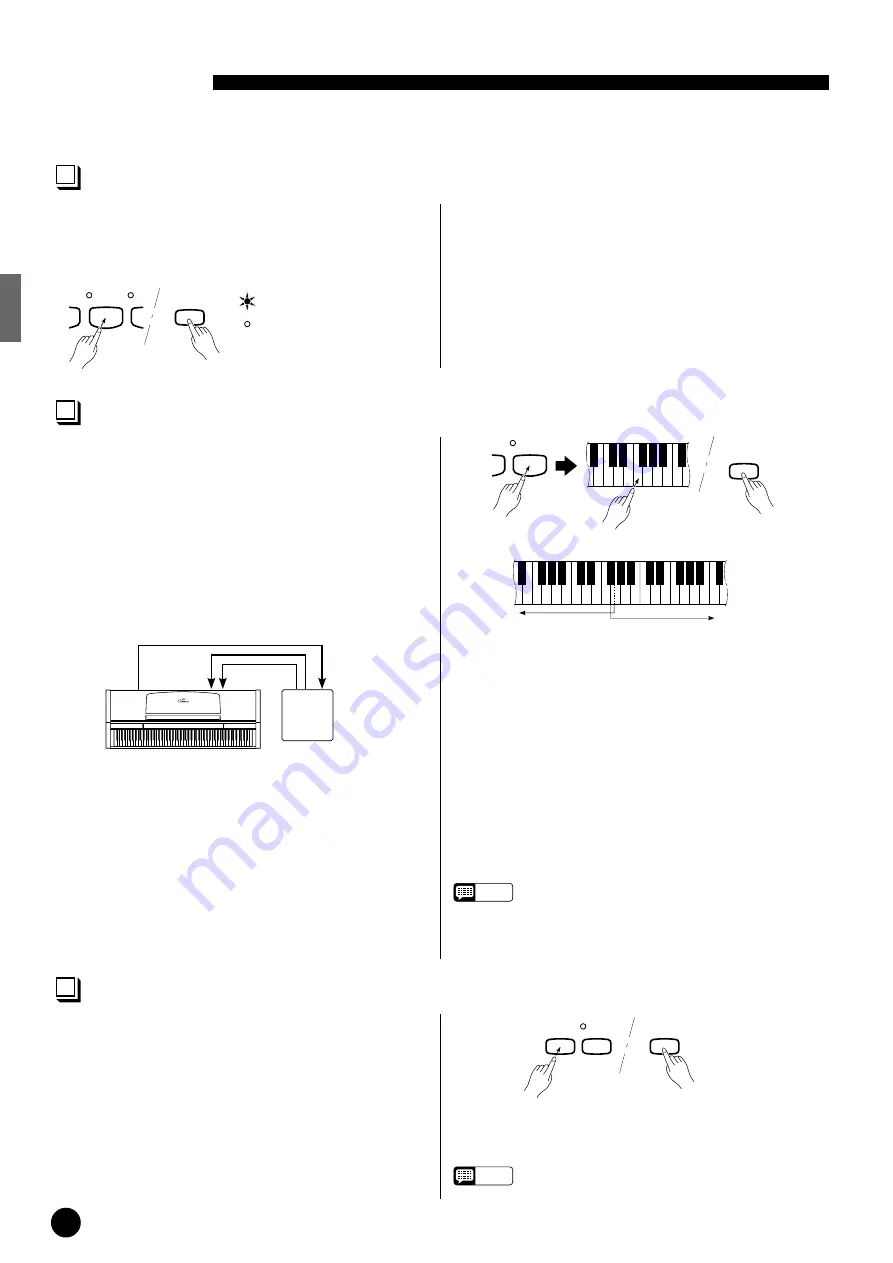
16
○ ○ ○ ○ ○ ○ ○ ○ ○ ○ ○ ○ ○ ○ ○ ○ ○ ○ ○ ○ ○ ○ ○ ○ ○ ○ ○ ○ ○ ○ ○ ○ ○ ○ ○ ○ ○ ○ ○ ○ ○ ○ ○ ○ ○ ○ ○ ○ ○ ○ ○ ○ ○ ○ ○ ○ ○ ○ ○ ○
MIDI Functions
The Multi-Timbre Mode
...........................................................................................................................................................
The Multi-Timbre mode is a special mode in which the Clavinova
voices can be independently controlled on different MIDI channel
numbers by an external MIDI device. The Multi-Timbre mode can be
activated as follows:
NO
HARPSI-
CHORD
P
OR
MIDI/TRANSPOSE
HARPSI-
CHORD
HARPSI-
CHORD
= Multi-Timbre Mode ON
= Multi-Timbre Mode OFF
Z
Hold down the [MIDI/TRANSPOSE] button.
X
Press the [HARPSICHORD] voice selector. If the HARPSI-
CHORD LED is lit when the [HARPSICHORD] voice selector
is pressed, you have turned the Multi-Timbre mode ON. If the
HARPSICHORD LED is not lit when the [HARPSICHORD]
voice selector is pressed, you have turned the Multi-Timbre mode
OFF.
C
Release the [MIDI/TRANSPOSE] button.
The MIDI Split & Left Local OFF Mode
...................................................................................................................
In the MIDI split mode one section of the Clavinova keyboard is
used to play a Clavinova voice in the normal way, while the remain-
ing section is used to play a second MIDI keyboard or tone generator
such as the Yamaha DOU-10 Disk Orchestra Unit. In this mode the
right-hand section of the keyboard is used to play an internal
Clavinova voice, while the left-hand section of the keyboard plays the
external keyboard or tone generator. Playing the left-hand section of
the keyboard produces no sound from the Clavinova. The “split
point,” or the key that divides the left- and right-hand sections of the
keyboard can be set at any desired key.
SPLIT POINT
▼
Left-hand section plays
a DOU-10 bass voice.
Right-hand section plays a
Clavinova piano voice.
MIDI/TRANSPOSE
PSI-
RD
PIPE
ORGAN
Z
Press the [PIPE ORGAN] voice selector while holding down the
[MIDI/TRANSPOSE] button. The PIPE ORGAN LED will
flash.
X
While still holding the [MIDI/TRANSPOSE] button, press the
key on the keyboard at which you want to set the split point. The
PIPE ORGAN LED will light continuously. The split-point
becomes the first key of the left-hand section.
C
Release the [MIDI/TRANSPOSE] button.
V
To return to the normal full-keyboard mode, hold the [MIDI/
TRANSPOSE] button and press the [PIPE ORGAN] voice
selector, then release both buttons.
NOTE
• When the power is turned ON the default split point key
— F
#
2 — will be automatically selected. If a new split
point is selected it remains active until the power is
turned OFF or a different split point is selected.
Bulk Data Dump
.............................................................................................................................................................................
This function is used to transmit all data stored in the Recorder
memory to a MIDI data storage device such as the Yamaha DOU-10
Disk Orchestra Unit, other sequence recorders, or MIDI compatible
computers.
MIDI/TRANSPOSE
REC
START/
STOP
RECORDER
Z
Hold [MIDI/TRANSPOSE] and press the [START/STOP]
button. Transmission will begin.
X
Release the buttons.
NOTE
• Bulk dump will not function when the metronome is on
or when the recorder is in operation.
DOU-10
OUT PUT
R
L
AUX IN
L
R
MIDI OUT
MIDI
IN
Clavinova
(Set to receive on MIDI
channel 2)
The MIDI split mode is useful if, for example, you want to play a
piano (Clavinova) voice with the right hand while playing a synthe-
sizer bass line or string section with the left hand.
When the MIDI split mode is activated, notes played on the left-
hand section are transmitted via the Clavinova MIDI OUT connector
on MIDI channel 2. Notes played on the right-hand section are
transmitted on the “basic channel” (i.e. the channel set using the
MIDI channel selection function described previously).






















